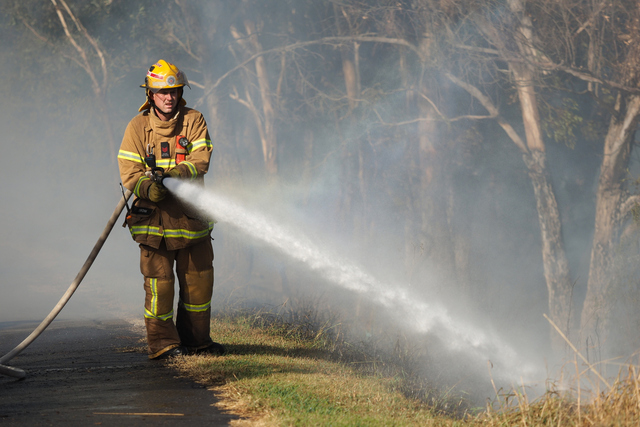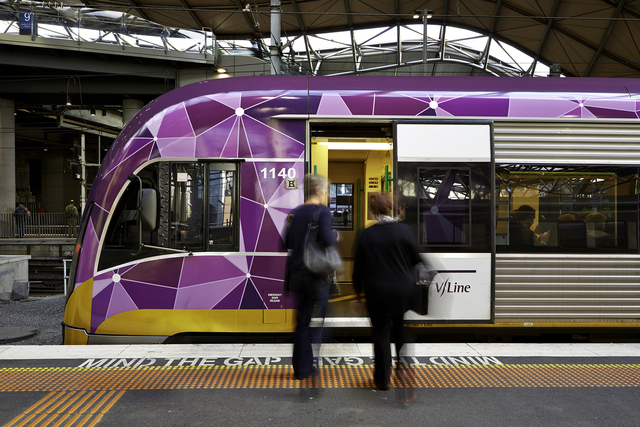VICTORIA has been shaken by more than 60 aftershocks since a magnitude 5.3 earthquake rattled Gippsland last night, the largest quake in the state in more than a century.
The earthquake struck at 8.53pm, rattling buildings and frightening residents from Gippsland to the western district and as far north as the NSW town of Wagga Wagga.
In Melbourne, residents reported feeling the quake all over the metropolitan area — from the Dandenongs in the east to Bentleigh in the south-east, Pascoe Vale in the west and through the inner city.
Melton resident Rennea Burgess said she had been watching television when her home began to shake.
“Our back door leading into garage started rattling,” she said.
“I honestly thought someone was in [the] shed rattling the handle trying to break in.
Got any video or pictures? Tell us your story, what you felt, and how you felt. Email us here.
Geoscience Australia said the epicentre was 10 kilometres south-west of Moe in the Latrobe Valley, and 9.9 kilometres underground. People reported feeling the ground shaking for between 15 and 60 seconds.
Geoscience Australia seismologist David Jepsen this morning said about 60 aftershocks had struck in the area around the initial earthquake, and they could continue rumbling for weeks.
‘‘There were some bigger ones to start with, a couple about 3.5-magnitude. The first one was a couple of hours after the [initial earthquake],’’ he said.
‘‘A magnitude-3.5 aftershock is about probably about 1000th of the energy of the main shock. They’re much smaller but people would have felt them in the local area, then they got smaller from there. Most of them are quite tiny and wouldn’t have been felt at all.
‘‘We don’t know how long they’re going to last for but it’s following a pattern where they’re dropping off in magnitude and frequency. They could go for a couple of days or weeks, we just don’t know.’’
Mr Jepsen said those who felt the earthquake had flocked to the Geoscience Australia website last night to report their experiences, including some reports of minor damage.
The Geoscience Australia website crashed under the load. When Geoscience was able to restore its site it had the news that the quake that rocked Victoria was the biggest in the state for 109 years.
‘‘Some people have seen cracks in their houses and things like that, and some of the supermarkets in the local region (surrounding Moe) had products obviously knocked off their shelves,’’ he said.
‘‘A lot of people would have experienced objects on bookshelves toppling over, but we haven’t had reports of major damage.’’
State Emergency Service spokesman Lachlan Quick said there had been around 30 calls for help, mainly in Gippsland, but no reports of injury.
‘‘It’s been mostly low level building damage – a chimney collapse in Moe, a garage has collapsed, some cracked walls but nothing major,’’ he said.
Last night’s earthquake not as strong as the 5.6 quake that devastated central Newcastle in 1989, and there were no immediate reports of serious property damage or injury.
US seismologists initially reported a 5.2 quake near Melbourne. Geoscience Australia later measured it at 5.5, and then revised it down to 5.3 — still making it one of the larger mainland Australian quakes recorded in decades.
Mr Jepsen said the motion of plates around the Pacific region caused the Australian continent to be compressed.
‘‘That compression leads to a building of stresses within the earth’s crust. Once that stress exceeds the strength of the rock, it will break and release energy. That’s how we generally see earthquakes occurring in Australia, a build up and then pop.’’
Moe Hotel chef David Warner, 22, was cleaning the kitchen when the quake struck. “I just heard this big bang and I thought it was a crane falling on the roof,” he said.
“Honestly I feared for my life for a second there, I thought the roof was collapsing. I just bolted for the door because I thought that was the end,” Mr Warner said. “About half the venue ran out the front in a bit of a panic.”
Elwood resident Andrew Chapman, who was in the New Zealand city of Christchurch for the devastating September 2010 earthquake, told The Age he felt two significant waves of shaking lasting up to a minute. “Our house was seriously swaying as we bolted outside,” he said.
“It was very unexpected . . . we left Christchurch because we didn’t want to be in an earthquake zone and Melbourne was a safe place to go to,” he said.
“We’re feeling very unnerved because I suppose it’s reignited all those anxieties and feelings from when we lived in Christchurch.”
Anthony Atkin, the duty manager of the Criterion Hotel at Trafalgar, just west of Moe, said he feared for his life when the quake hit.
“I thought the roof was going to fall down,” Mr Atkin said.
“Everyone in the hotel ran outside, it was like a train was coming through the hotel.
“I’ve been here for 44 years and never felt anything like it.”
The federal minister responsible for insurance, Bill Shorten, last night urged people to make safety their first priority after the quake. “This is the biggest earthquake to hit Victoria for over 109 years,” he said.
“It will take some days to determine the full extent of damage. In the meantime, peoples’ personal safety is always the first priority.”
Moe police constable Chris Hand was enjoying a cup of coffee when the quake hit.
“I had the cup sitting on the table and it spilled over,” he said. “We’ve had a lot of calls but no one is reporting any damage or injuries at this stage.
“It was a decent-size rumble, the biggest I’ve ever felt.”
Readers who swamped The Age with calls and emails reported feeling the tremor in country areas including Bright, Wangaratta, Wodonga, Euroa, Shepparton and Echuca.






